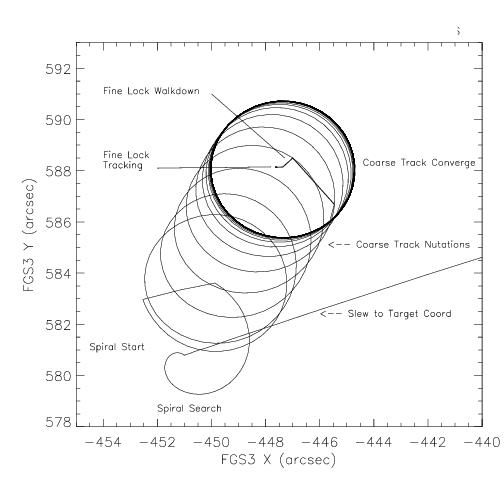A.2 Target Acquisition and Position Mode Tracking
In this section we review the acquisition and tracking sequence. The flags and status bits are defined in detail in the FGS Data Handbook.
A.2.1 Slew to the Target
To initiate the acquisition of a target, the 486 slews the FGS Instantaneous Field of View (IFOV) to the expected location of the target. Upon arrival, the FGE initiates the search and track sequence: Search, CoarseTrack, and FineLock. Figure A.1 demonstrates the actual movement of the IFOV during a target acquisition.
- The end of the slew to the target’s expected location.
- A short spiral search.
- CoarseTrack nutations to locate the photocenter.
- WalkDown to locate interferometric null.
- Tracking in FineLock.
Note: The example depicted in Figure A.1 was chosen for its clear demonstration of the phases of the acquisition. This example is atypical, as the 7˝ difference between the expected location and the true location of the target is unusually large. More typical miss-distances are 0.3" to 1.00".
A.2.2 Search
In the search phase, the IFOV, under FGE control, steps every 25 msec along an outward spiral while the PMTs count the photons received from the 5˝ × 5˝ patch of sky observed in the IFOV. When the counts fall within a specified tolerance, the FGE declares the spiral search a success, and the instrument transitions to CoarseTrack. By default, the radius of the spiral search is 15 arcsec, but can be a large as 90 arcsec.
A.2.3 CoarseTrack
After a successful search, the FGE attempts to acquire and track the star in CoarseTrack. The FGS locates the photocenter by comparing the photon counts from the four PMTs as the IFOV nutates in a 5˝ diameter circular path around the target.
If the PMT data ever indicate the star is no longer present, the FGS reverts back to Search mode, beginning where it left off on the search spiral to resume its outward search for the star.
A.2.4 FineLock
Upon completion of the CoarseTrack, the FGS attempts to acquire the target in FineLock. This activity involves the acquisition and tracking of an object’s interferogram. The fundamental interval of time during FineLock is the Fine Error averaging time (denoted as FESTIME—see Chapter 7). During an FESTIME the FGS integrates the PMT counts while holding the IFOV fixed.
The acquisition begins with the “WalkDown to FineLock,” or simply the WalkDown. The FGE commands the FGS’s IFOV to a position offset or “backed-off” from the photocenter (determined by CoarseTrack). Here at the very beginning of the WalkDown, while the IFOV is far from the fringe, the FGE collects data from the two PMTs on each of the X and Y channels to compute an average sum (SUM) and difference (DIFF) of the PMT counts on each channel. The integration time is 0.4 sec or one FESTIME, whichever is larger. The FGE then uses these values to compensate for any difference in the response of the two PMTs on a given axis. Thus, the X-axis Fine Error Signal (FES) for the remainder of the Position Mode observation will be:
| \small{{\rm Q}_X=\frac{({\rm A}_X-{\rm B}_X-{\rm DIFF}_X)}{({\rm SUM}_X)}} |
where AX and BX are the average photon counts/25 msec (from PMTXA and PMTXB) integrated over the FESTIME, and DIFFX and SUMX are the average difference and sum of the PMTXA, PMTXB counts per 25 milliseconds (as computed at the start of the walkdown). The Y-axis FES is computed in a similar fashion.
Figure A.2 shows the instantaneous value of the normalized difference of the PMT counts along the Y-axis during a WalkDown to FineLock. The fact that the null lies to the positive side of the Y-axis S-Curve (S(y) > 0.0) clearly demonstrates the need for the DIFF-SUM adjustment to locate the true interferometric null. The reference to “pipeline corrected null” in Figure A.2 refers to the true values of DIFF and SUM as computed by the astrometry pipeline, which uses the photometry during the entire WalkDown to achieve a better signal-to-noise for these values. (See Chapter 7 for additional details on the FGS pipeline.)
If the FGS does not detect the S-Curve after 130 steps (i.e., after having “walked” 810 mas), the FineLock acquisition fails and the “scan step limit exceeded” flag is set. The IFOV will then remain positioned at the end of the WalkDown path until the 486 slews it to the expected location of the next target in the observing sequence. The observer will be provided with the 40 Hz photometry and star selector angles from which the Fine Error Signal can be reconstructed and analyzed to determine the cause of the failure. The star must be acquired on both axes for the observation to succeed.
When the S-Curves on both axes have been encountered and the 3-hit algorithm satisfied, the FGS is said to be tracking the object in FineLock. Figure A.3 shows the IFOV’s position for both the WalkDown and FineLock tracking in local detector space. Notice the interferometric null is first encountered along the Y-axis. The IFOV must walk an additional 0.2" along the X-axis to find its interferometric null. This is typical FGS3, and is due to a bias in the CoarseTrack photocenter and the FineLock (interferometric) null. FGS1r has a different bias, with the X-axis null encountered some 0.440" before the Y-axis null. These biases do not degrade the instruments scientific performance.


